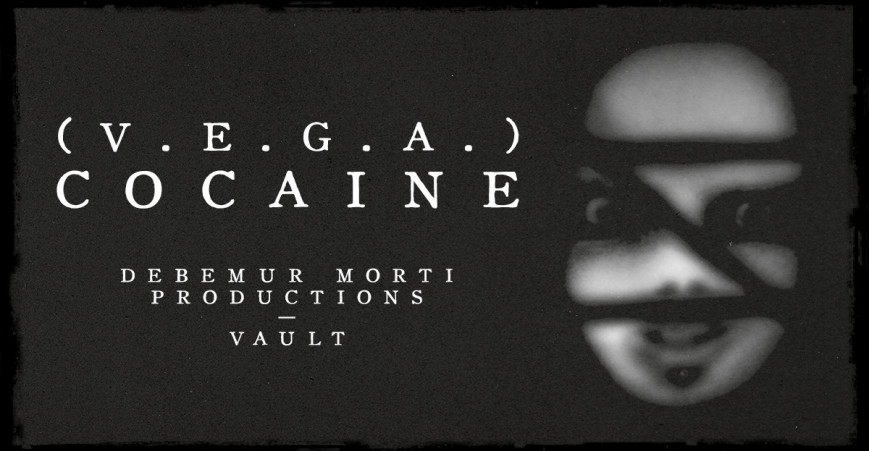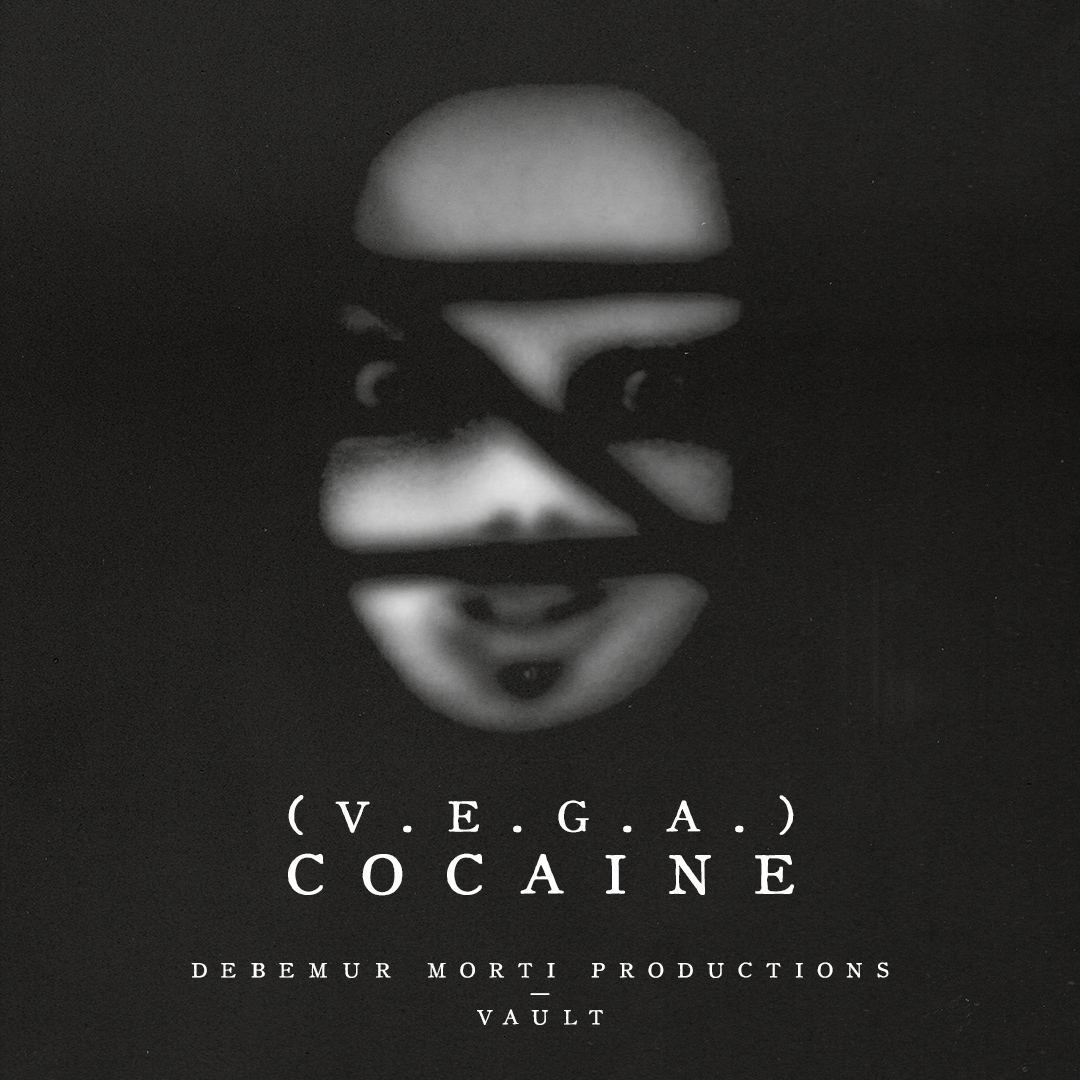Blog search
Artists
- Aara
- Akhlys
- Anfauglir
- Archgoat
- Arkona
- Aversio Humanitatis
- Behexen
- Beneath Moonlight
- Blood Abscission
- Blut Aus Nord
- Bong-Ra
- Cailleach Calling
- Eitrin
- Ershetu
- Godkiller
- I.C.E.
- Inferno
- Insect Ark
- Kaleikr
- Light Of The Morning Star
- Lychgate
- Martröð
- Miserere Luminis
- Modern Rites
- Mütterlein
- Óreiða
- Other World
- Pestifer
- Pestilength
- Pestilent Hex
- Plebeian Grandstand
- Pure Wrath
- Selbst
- Servants Of Chaos Festival
- Slidhr
- Sühnopfer
- Taubrą
- Terra Tenebrosa
- The Lovecraft Sextet
- Throane
- Ulcerate
- Waidelotte
- White Ward

DMP Vault – Part VII, "Cocaine"
So far the Vault has covered a handful of indelible pieces of the DMP puzzle which helped mould the label into today's form. Each DMP release is considered a reflection of the label's ethos, drive and vision. Today's Vault chapter is no different. In 2006 we were privileged to join forces with the Italian-based assemblage (V.E.G.A.) to unleash CD and digital editions of their distinctive debut album. Listen to the album here:
(V.E.G.A.) is an acronym standing for Vacuum Era Gelid Atmosphere, a peculiar alloy of words indicating an intricate tour de force. One should consider it a warning that this is not music for the faint-hearted.
Originally released in 2002, "Cocaine" is an almost hour-long work of abstruse Black Metal art. As the title suggests, "Cocaine" does deliver thrills. It is a harsh and almost intoxicating musical state; made to titillate and provoke. (V.E.G.A.) create walls of sound, trapping the listener in overstimulation, their fate becoming clearer with the passage of time.
The band uses tortuous distortion with bleak Industrial and electronic overtones, blending the harsh and the euphonious in a seamlessly-executed use of contrast. The varied vocal performances act as the cement strengthening "Cocaine's" foundations, the transition from a barbaric onslaught into ethereal cleans adding further depth to the perpetually crushing atmosphere. The changes in tempo, instrumental flow and emotional density appear to mimic the titular drug's rollercoaster rhythm. To heighten the overwhelming evocative effect, the album is filled with outré samples, adding layers of eeriness. There are numerous moments to make you feel ill-at-ease, whether your first time listening or the tenth.
"Cocaine" is an almost hour-long trip, brimming with momentum. It sweeps you up into a high and leaves an indelible imprint. Observing the music passively, from a distance, you appreciate the songwriting and ambiance. But once you give in and actively take part in the experience the rush can leave you with disorderly confusion of the purest kind. Stars can't shine here.
Following "Cocaine" the band released an additional two full-length albums: again joining forces with DMP for 2008 sophomore release "Alienforest - A Sick Mind's Hologram", a 74-minute expedition into hallucinatory expressionism, and then the following year issuing "Far From You", a self-released collection of older experimental pieces.
Nothing about (V.E.G.A.) can be described as predictable, so perhaps the trio have yet to play their last tune. For the time being it is highly recommended you take a trip down memory lane and revisit this obscure gem.

We contacted mastermind Ravez for some unique insight into the creation of "Cocaine" and the entity which is (V.E.G.A.).
Q: This album was released in 2002, but the band was founded in 1998. Can you tell us a bit about those earliest days of your artistic collective? How do you now, over 20 years later, recall this creative period?
It sure feels like a life ago. What I remember is that we recorded "Cocaine – A Sick Mind's Hologram" first, but we wanted a more professional sound. A friend of ours had a recording studio, so we decided to re-record the album, starting with the drums. Once the drums were done by Janos, it was my turn to record the guitars, but I ended up rewriting most of the music. So, in the end some things sound similar and some completely new. It was a very long process, but I am glad we got to do it. We never played live as a band, so we only really had this chance to get the music out of our system, and the music was ever evolving in my head at least, so the recording would only be a snapshot in time of what we envisioned. That's why even a re-recording which was supposed to be the same album, just with a better sound, turned out to be very different. It is a bit like trying to shape water with your hands. I like the idea of just letting art flow through you and have someone take a snapshot in time.
Q: Could you grant us a little insight into the "technical" aspects of your music? How was "Cocaine" composed, recorded and produced?
Oh, back then it wasn't very fancy, Janos didn't even own a drum set. We'd meet at my place, and he would sit on the bed tapping his hands on his knees for the snare/toms and the feet on the floor for the double bass drum. That was possible free of charge. Otherwise, we'd have to book a rehearsal room for a few hours, but we couldn't do that too often. This was only possible when we felt like the composition was solid. At that point we could record a song on tape and then listen in the car on the way back. It was so cool to be able to listen to what we did. I probably still have those tapes somewhere. My guitar was a red Charvel Jackson which I bought second-hand in the early 90s. The album was recorded by Ettore Rigotti (a friend from high school) at his Metal House Studios using Emagic Logic and a Yamaha 02r recording console if I remember correctly. I don't recall the drum set, but I remember we used a trigger for the snare.
We actually have videotapes of the recording sessions of "Cocaine", haha! What's funny is that the studio was just a living room in my friend's house. I remember I had up to eight lines of guitars, which would have made it impossible to play live. I am fascinated by harmonies, so I tend to play single note melodies for each guitar so that they form an ever-evolving chord progression, on top of a couple of rhythm guitars. I never really learned to play guitar. I always played by ear, so I was basically humming a melody, recording it, playing it back and recording another one on top and so on. It's exhausting and time consuming, which is why I didn't continue composing with guitar, as I'd have to transcribe every line just to remember it.
Q: There are various lyrical topics to be found on "Cocaine". Sometimes it seems eclectic, in other moments one has the feeling there are certain kind of motifs and feelings which traverse through all the songs. What were the lyrics inspired by?
It was all very random. Ideas just flow all the time, and we could use them at any time, stuff that is brand new or years old just merged. I think back then we watched a couple of movies like "Christiane F." and "Lilja Forever" which gave us some influence on the music and lyrics, but in my mind what I really like is the contrast of opposites. So, something as bad a drug addiction, for example, was pictured against the addiction to music and turned into Art. This is what "Cocaine" is about for me. It's the soul breaking out of the body and mind cage. Janos wrote most of the lyrics. I think I only wrote "Kill Me", which was based on the idea that no God is going to stop you from killing yourself. But also, that death is not the end. Drugs can mess with your head so much, but so does everyday life. It's all in the perception of your mind. And the mind can be your cage or your intergalactic train express. I think I wanted to turn something negative into a positive experience, one that sets you free instead of a prisoner, free of your own self. This is "Cocaine".
Q: "Cocaine" featured two different cover artworks – a more abstract piece and one in which a face is clearly visible. Could you tell us more about these pictures? How did you come up with them? And in what relation do they stand?
The first one was a frame we took from a video we made of a friend dancing in a cold night in front of a cement wall listening to THE DELTA (which is Industrial trance music), then I played with it in Photoshop. I liked how it's a balance between a dream and a nightmare state, it depicts the mood of the album well. The second one was something I painted in Photoshop while learning the software in digital graphics school, and I realized it was very dark but smiling at me, like a reflection of my dark self. I had to use it for the Debemur Morti Digipack version, it was just perfect.
Q: After "Cocaine", it took you a couple of years to release follow-ups "Alienforest – A Sick Mind's Hologram" and "Far From You". "Alienforest…" is specifically related to "Cocaine" and does include some tracks which were already present on "Cocaine". However, "Far From You" is something entirely different. How would you interpret the relationship between these three works of Art?
So, this is the timeline: we composed/recorded "Cocaine - A Sick Mind's Hologram" in the late ‘90s, but it was a bedroom production. The sound was so raw that we felt like we couldn't even publish it, so we decided to go to my friend's studio to record it properly. But we ended up rewriting most of the music because we had so many ideas and new influences. That's when "Cocaine" was recorded. "Alienforest – A Sick Mind's Hologram" was simply the official release of "Cocaine – A Sick Mind's Hologram". Then years later we had 5 tracks that we messed with over the years, ranging from electronic music to very experimental to avantgarde etc. I felt it was like a broken mirror that was picturing very well how far we went into the unknown. We turned those tracks into "Far From You" which was meant to be a way to say goodbye to what we did up until then. We were basically free and floating in space at that point, which is why most people can't relate much to it. I think it's too far from something that can be understood. It's not Metal, it's weird, and I love it because of how unique it is. After that we never published any more music for the band. Mainly because we started working and could not dedicate any more time to it, also we opened up a lot in terms of music taste, nowadays we listen to pretty much everything.
Posted on 12-10-2023
No products
To be determined Shipping
0,00 € Total